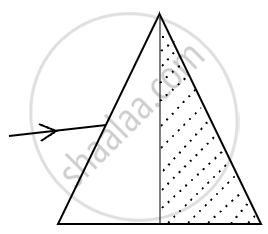Advertisements
Advertisements
Question
Three rays (1, 2, 3) of different colours fall normally on one of the sides of an isosceles right angled prism as shown. The refractive index of prism for these rays is 1.39, 1.47 and 1.52 respectively. Find which of these rays get internally reflected and which get only refracted from AC. Trace the paths of rays. Justify your answer with the help of necessary calculations.
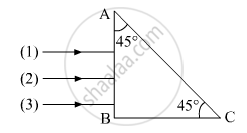
Solution
Critical angle for ray 1:
\[\sin\left( c_1 \right) = \frac{1}{\mu_1} = \frac{1}{1 . 39}\]
\[ \Rightarrow c_1 = \sin^{- 1} \left( \frac{1}{1 . 39} \right) = 46 . 00°\]
Similarly, critical angle of ray 2:
\[\sin\left( c_2 \right) = \frac{1}{\mu_2} = \frac{1}{1 . 47}\]
\[ \Rightarrow c_2 = \sin^{- 1} \left( \frac{1}{1 . 47} \right) = 42 . 86°\]
Similarly, critical angle of ray 3:
\[\sin\left( c_3 \right) = \frac{1}{\mu_3} = \frac{1}{1 . 52}\]
\[ \Rightarrow c_3 = \sin^{- 1} \left( \frac{1}{1 . 52} \right) = 41 . 13°\]
The ray 1 will get totally internally reflected from the side AC with critical equal to 46°. Critical angle of ray 1 is greater than that of i (45°) . Critical angle of ray 2 and 3 is less than that of i. Hence, they will be refracted from the side AC.
APPEARS IN
RELATED QUESTIONS
At what angle should a ray of light be incident on the face of a prism of refracting angle 60° so that it just suffers total internal reflection at the other face? The refractive index of the material of the prism is 1.524.
Find the angle of incidence at face AB so that the emergent ray grazes along the face AC.
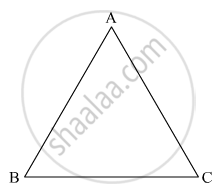
Write the relationship between angle of incidence ‘i’, angle of prism ‘A’ and angle of minimum deviations for a triangular prism.
Three light rays red (R), green (G) and blue (B) are incident on a right angled prism ‘abc’ at face ‘ab’. The refractive indices of the material of the prism for red, green and blue wavelengths are 1.39, 1.44 and 1.47 respectively. Out of the three which colour ray will emerge out of face ‘ac’? Justify your answer. Trace the path of these rays after passing through face ‘ab’.
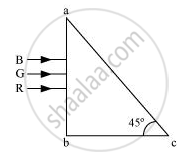
A flint glass prism and a crown glass prism are to be combined in such a way that the deviation of the mean ray is zero. The refractive index of flint and crown glasses for the mean ray are 1.620 and 1.518 respectively. If the refracting angle of the flint prism is 6.0°, what would be the refracting angle of the crown prism?
A prism is made of glass of unknown refractive index. A parallel beam of light is incident on the face of the prism. The angle of minimum deviation is measured to be 40°. What is the refractive index of the material of the prism? The refracting angle of the prism is 60°. If the prism is placed in water (refractive index 1.33), predict the new angle of minimum deviation of a parallel beam of light.
The refractive index of a prism whose angle A = 60° is `sqrt2`. Then the angle of minimum deviation δm will be ______.
An isosceles prism of angle 120° has a refractive index 1.44. Two parallel monochromatic rays enter the prism parallel to each other in air as shown. The rays emerge from the opposite faces:

A ray PQ is incident normally on the face AB of a triangular prism of refracting angle 60° as shown in figure. The prism is made of a transparent material of refractive index `2/sqrt(3)`. Trace the path of the ray as it passes through the prism. Calculate the angle of emergence and the angle of deviation.
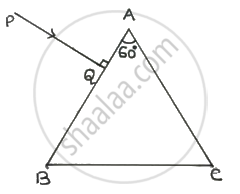
A ray of light when incident upon a thin prism suffers a minimum deviation of 39°. If the shaded half portion of the prism is removed, then the same ray will ______.
